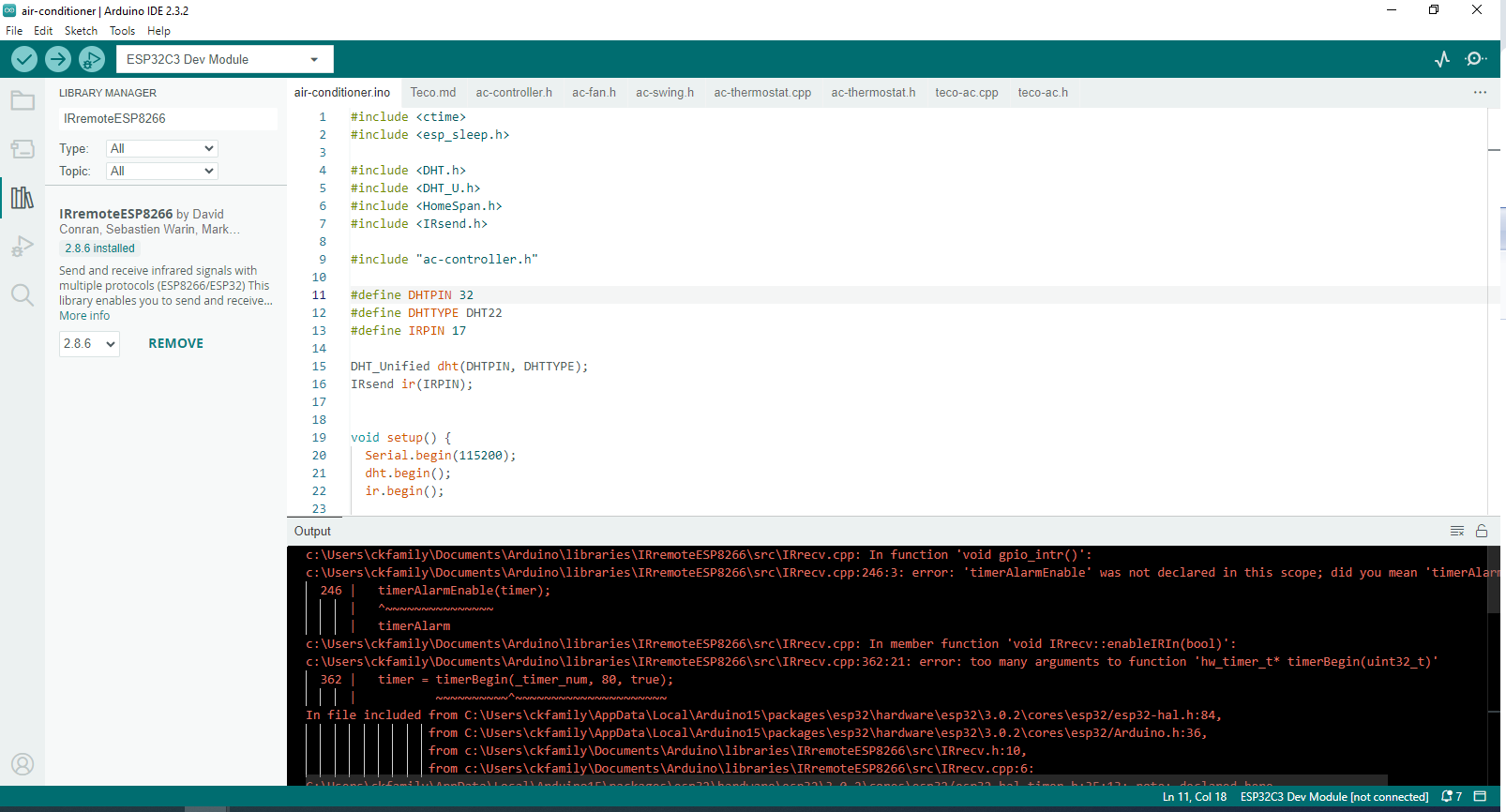实现基于HomeKit的空调控制
https://github.com/dingyiyi0226/homekit-air-conditioner https://github.com/LouisLee985/Homekit_ESP_AC_IRemote
报错
 |
|---|
| 报错 |
HomeSpan逼着把ESP32库升级,升级之后采用的是IDF-5,而IRremoteESP8266并未兼容IDF-5。
再次尝试把空调做出来,身边空调的遥控器背面型号为YAP0F,因为是型号是格力,很自然会打开一个Gree的例子来控制,结果控制无效。这次先使用PulseViewer来抓包,再结合格力空调 YAPOF3 红外编码以及格力空调红外编码解析,就决定改用Kelvinator的开空调Demo来测试,果然直接可以打开空调。
/* Copyright 2016, 2018 David Conran
*
* An IR LED circuit *MUST* be connected to the ESP8266 on a pin
* as specified by kIrLed below.
*
* TL;DR: The IR LED needs to be driven by a transistor for a good result.
*
* Suggested circuit:
* https://github.com/crankyoldgit/IRremoteESP8266/wiki#ir-sending
*
* Common mistakes & tips:
* * Don't just connect the IR LED directly to the pin, it won't
* have enough current to drive the IR LED effectively.
* * Make sure you have the IR LED polarity correct.
* See: https://learn.sparkfun.com/tutorials/polarity/diode-and-led-polarity
* * Typical digital camera/phones can be used to see if the IR LED is flashed.
* Replace the IR LED with a normal LED if you don't have a digital camera
* when debugging.
* * Avoid using the following pins unless you really know what you are doing:
* * Pin 0/D3: Can interfere with the boot/program mode & support circuits.
* * Pin 1/TX/TXD0: Any serial transmissions from the ESP8266 will interfere.
* * Pin 3/RX/RXD0: Any serial transmissions to the ESP8266 will interfere.
* * ESP-01 modules are tricky. We suggest you use a module with more GPIOs
* for your first time. e.g. ESP-12 etc.
*/
#include <Arduino.h>
#include <IRremoteESP8266.h>
#include <IRsend.h>
#include <ir_Kelvinator.h>
const uint16_t kIrLed = 1; // ESP8266 GPIO pin to use. Recommended: 4 (D2).
IRKelvinatorAC ac(kIrLed); // Set the GPIO to be used for sending messages.
void printState() {
// Display the settings.
Serial.println("Kelvinator A/C remote is in the following state:");
Serial.printf(" %s\n", ac.toString().c_str());
// Display the encoded IR sequence.
unsigned char* ir_code = ac.getRaw();
Serial.print("IR Code: 0x");
for (uint8_t i = 0; i < kKelvinatorStateLength; i++)
Serial.printf("%02X", ir_code[i]);
Serial.println();
}
void setup() {
ac.begin();
Serial.begin(115200);
delay(200);
// Set up what we want to send. See ir_Kelvinator.cpp for all the options.
// Most things default to off.
Serial.println("Default state of the remote.");
printState();
Serial.println("Setting desired state for A/C.");
ac.on();
ac.setFan(1);
ac.setMode(kKelvinatorCool);
ac.setTemp(26);
ac.setSwingVertical(false, kKelvinatorSwingVOff);
ac.setSwingHorizontal(true);
ac.setXFan(true);
ac.setIonFilter(false);
ac.setLight(true);
}
void loop() {
// Now send the IR signal.
#if SEND_KELVINATOR
Serial.println("Sending IR command to A/C ...");
ac.send();
#endif // SEND_KELVINATOR
printState();
delay(5000);
}
那就可以把其和HomeSpan柔和在一起做出第一个空调控制器。
自发自收
想要实现解析,第一步先搞一个自发自收,因为涉及到的软硬件越少越好,结果大意的浪费了一天的时间,我是这样尝试的,我把发送和接收的GPIO接到了一起,就要看看能否识别一个正常发送的信号,怎么解析都不行,最后看到发送的协议数据那么少,收到的字节却那么多,开始觉得这其中必须有问题,我打印的发送是 调制 之前的,而接收是本来是解调之后的,但是却收到了解调之前的,最终定位到要想像串口、433那样可以短接管脚方式来测试,就得把发送的调制去掉,所以以下例子中的IRKelvinatorAC ac(kIrLedPin, false, false);特别关键。当然_IR_ENABLE_DEFAULT_ true应该也是非常关键的,我还没有做进一步反验证。
#define _IR_ENABLE_DEFAULT_ true
#include <IRremoteESP8266.h>
#include <IRsend.h>
#include <IRrecv.h>
#include <IRac.h>
#include <IRutils.h>
// uni homekit board
#define STATUS_PIN 7
#define CONTROL_PIN 9
#define POWER_PIN 10
#define OUT_DN 1
#define OUT_DP 0
const uint16_t kIrLedPin = OUT_DN; // 红外发射引脚 (D2)
const uint16_t kIrRecvPin = OUT_DP; // 红外接收引脚 (D5)
const uint8_t kButtonPin = CONTROL_PIN; // 按钮引脚 (D3 / GPIO0)
IRKelvinatorAC ac(kIrLedPin, false, false);
IRrecv irrecv(kIrRecvPin, 1024, 50, true); // buffer大小为1024,超时50ms
decode_results results;
bool lastButtonState = HIGH;
void setup() {
Serial.begin(115200);
delay(200);
// 设置按钮输入
pinMode(kButtonPin, INPUT_PULLUP);
// Enalbe Power
// pinMode(POWER_PIN, OUTPUT);
// digitalWrite(POWER_PIN, HIGH);
// 初始化红外发射
ac.begin();
ac.setPower(true);
ac.setTemp(24);
// ac.setFan(kKelvinatorFanAuto);
ac.setMode(kKelvinatorCool);
// 初始化接收
irrecv.enableIRIn();
Serial.println("按下按钮发送 Kelvinator 指令并接收");
}
void printState() {
// Display the settings.
Serial.println("Kelvinator A/C remote is in the following state:");
Serial.printf(" %s\n", ac.toString().c_str());
// Display the encoded IR sequence.
unsigned char* ir_code = ac.getRaw();
Serial.print("IR Code: 0x");
for (uint8_t i = 0; i < kKelvinatorStateLength; i++)
Serial.printf("%02X", ir_code[i]);
Serial.println();
}
void loop() {
//Serial.println("loop\n");
// 读取按钮状态(下降沿检测)
bool buttonState = digitalRead(kButtonPin);
if (lastButtonState == HIGH && buttonState == LOW) {
Serial.println("\n按钮按下,发送 Kelvinator 指令...");
printState();
ac.send();
delay(200); // 等待信号传播完成(视硬件而定)
// 启动接收
Serial.println("开始接收...");
unsigned long start = millis();
while (millis() - start < 2000) { // 最多等待2秒
if (irrecv.decode(&results)) {
Serial.println(results.decode_type);
Serial.println("接收到 IR 信号:");
Serial.println(resultToHumanReadableBasic(&results));
Serial.println(resultToSourceCode(&results));
irrecv.resume(); // 准备接收下一个
break;
}
}
Serial.println("接收结束。\n");
}
lastButtonState = buttonState;
}
日志
按下按钮发送 Kelvinator 指令并接收
按钮按下,发送 Kelvinator 指令...
Kelvinator A/C remote is in the following state:
Power: On, Mode: 1 (Cool), Temp: 24C, Fan: 0 (Auto), Turbo: Off, Quiet: Off, XFan: Off, Ion: Off, Light: Off, Swing(H): Off, Swing(V): 0 (Off)
IR Code: 0x09080050000000B009080070000000B0
开始接收...
Attempting Kelvinator decode
18
接收到 IR 信号:
Protocol : KELVINATOR
Code : 0x09080050000000B009080070000000B0 (128 Bits)
uint16_t rawData[279] = {9028, 4520, 686, 1538, 686, 518, 686, 518, 686, 1536, 686, 516, 686, 518, 686, 516, 686, 518, 686, 516, 686, 518, 686, 522, 686, 1536, 686, 518, 686, 518, 686, 516, 686, 518, 686, 518, 686, 516, 686, 516, 686, 518, 686, 516, 686, 516, 686, 516, 686, 518, 686, 516, 686, 518, 686, 516, 686, 518, 686, 1538, 686, 516, 686, 1536, 686, 530, 688, 516, 686, 1536, 686, 516, 686, 19308, 686, 518, 686, 516, 686, 516, 686, 516, 686, 518, 686, 518, 686, 516, 686, 518, 686, 516, 686, 518, 686, 516, 686, 518, 686, 516, 686, 516, 686, 518, 686, 516, 686, 518, 686, 516, 686, 516, 686, 518, 686, 516, 686, 516, 686, 516, 686, 518, 686, 518, 686, 516, 686, 518, 686, 518, 686, 1536, 686, 1538, 686, 516, 686, 1536, 686, 39704, 9016, 4512, 686, 1538, 686, 516, 686, 518, 686, 1536, 686, 516, 686, 518, 686, 516, 686, 518, 686, 518, 686, 516, 686, 518, 686, 1536, 692, 516, 686, 518, 686, 518, 686, 516, 686, 516, 686, 516, 686, 518, 686, 516, 686, 516, 686, 518, 686, 516, 686, 518, 686, 516, 686, 518, 686, 516, 686, 518, 686, 1536, 686, 1536, 686, 1538, 686, 522, 686, 516, 686, 1538, 686, 518, 686, 19526, 686, 518, 686, 516, 686, 516, 686, 516, 686, 520, 686, 518, 686, 516, 686, 518, 686, 516, 686, 518, 686, 516, 686, 518, 686, 518, 686, 516, 686, 518, 686, 516, 686, 516, 686, 516, 686, 518, 686, 516, 686, 516, 686, 516, 686, 518, 686, 516, 686, 516, 686, 518, 686, 516, 686, 516, 686, 1538, 686, 1536, 686, 516, 686, 1538, 686}; // KELVINATOR
uint8_t state[16] = {0x09, 0x08, 0x00, 0x50, 0x00, 0x00, 0x00, 0xB0, 0x09, 0x08, 0x00, 0x70, 0x00, 0x00, 0x00, 0xB0};
接收结束。